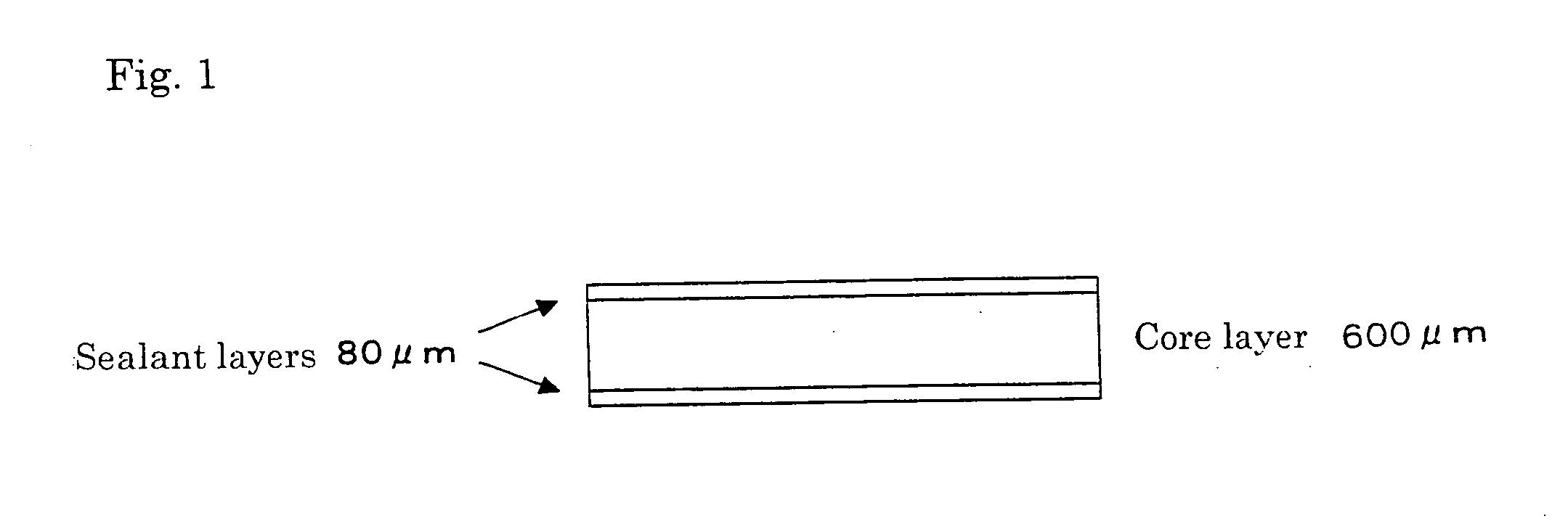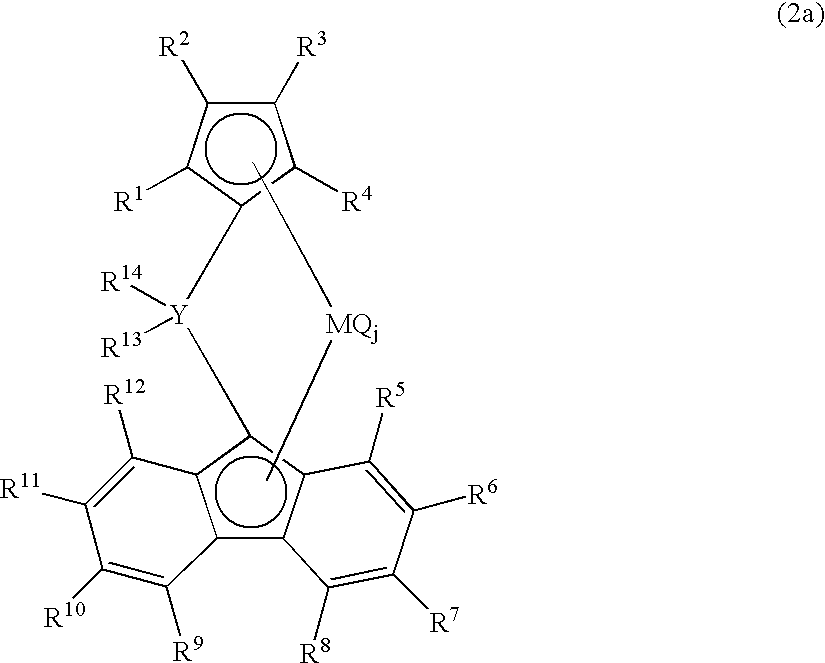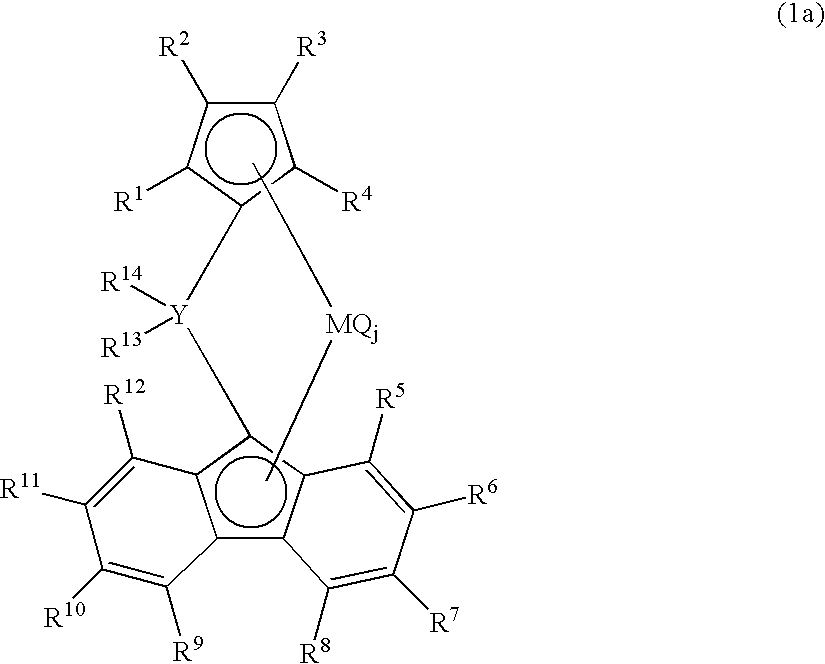Propylene copolymer, polypropylene composition, and uses thereof, transition metal compounds and catalyst for olefin polymerization
a technology of transition metal compounds and polypropylene, which is applied in the field of polypropylene compositions, polypropylene copolymers, and uses thereof, can solve the problems of reducing the heat resistance of polypropylene compositions, insufficient flexibility and impact resistance of polypropylenes, and difficulty in heat sealing films, etc., to achieve excellent flexibility, good moldability, and good impact resistance.
- Summary
- Abstract
- Description
- Claims
- Application Information
AI Technical Summary
Benefits of technology
Problems solved by technology
Method used
Image
Examples
examples
[0447] The present invention will be described in more detail with reference to the following examples, through the present invention should not be restricted by the examples.
[0448] Examples and Comparative Examples concerning to laminates prepared by using a propylene / 1-butene random copolymer (PBR), polypropylene composition (CC-1) or (CC-2), and polypropylene composition (CC-2) are described hereinafter.
[Methods for Measuring Physical Properties]
[1-Butene Content]
[0449] The 1-butene content was determined by utilizing 13C-NMR.
[Intrinsic Viscosity [η]]
[0450] The intrinsic viscosity was measured in decalin at 135° C. and indicated by dl / g.
[Molecular Weight Distribution (Mw / Mn)]
[0451] The molecular weight distribution (Mw / Mn) was measured using GPC-150C manufactured by Millipore Co., Ltd in the following manner.
[0452] As a separation column, TSK GNH HT was used. The column had a diameter of 27 mm and a length of 600 mm. The column temperature was set to 140° C. For a mobile...
example 1
Synthesis of PBR-1
[0467] In a 2000 ml polymerization reactor thoroughly purged with nitrogen, 900 ml of dried hexane, 60 g of 1-butene and triisobutylaluminum (1.0 mmol) were charged at room temperature, the inside temperature of the polymerization reactor was elevated to 70° C. and pressurized with propylene to 0.7 Mpa. A toluene solution obtained by allowing 0.002 mmol of dimethylmethylene(3-tert-butyl-5-methylcyclopentadienyl)fluorenyl zirconium dichloride to contact with 0.6 mmol in terms of aluminum of methyl aluminoxane (manufactured by Tosoh Fine chemical Co., Ltd) was added to the polymerization reactor. Polymerization was carried out for 30 min while keeping an internal temperature of 70° C. and a propylene pressure of 0.7 Mpa and then 20 ml of methanol was added and thereby the polymerization was ceased. After depressurization, a polymer was precipitated from the polymerization solution in 2 L of methanol, and was dried in vacuo at 130° C. for 12 hr.
[0468] The polymer wa...
example 2
Synthesis of PBR-2
[0470] The polymerization was carried out in the same procedure as Example 1 except that 917 ml of hexane and 50 g of 1-butene were charged and dimethylmethylene(3-tert-butyl-5-methyl cyclopentadienyl)fluorenyl zirconium dichloride was changed to diphenylmethylene (3-tert-butyl-5-methyl cyclopentadienyl) 2,7-di-tert-butylfluorenyl zirconium dichloride.
[0471] The polymer was obtained in an amount of 11.5 g. The polymer had a melting point of 86.3° C. and an intrinsic viscosity [η] of 2.11 dl / g. The physical properties of the resulting polymer were measured. The results are shown in Table 2.
PUM
| Property | Measurement | Unit |
|---|---|---|
| Temperature | aaaaa | aaaaa |
| Temperature | aaaaa | aaaaa |
| Temperature | aaaaa | aaaaa |
Abstract
Description
Claims
Application Information
 Login to View More
Login to View More - R&D
- Intellectual Property
- Life Sciences
- Materials
- Tech Scout
- Unparalleled Data Quality
- Higher Quality Content
- 60% Fewer Hallucinations
Browse by: Latest US Patents, China's latest patents, Technical Efficacy Thesaurus, Application Domain, Technology Topic, Popular Technical Reports.
© 2025 PatSnap. All rights reserved.Legal|Privacy policy|Modern Slavery Act Transparency Statement|Sitemap|About US| Contact US: help@patsnap.com



